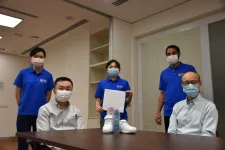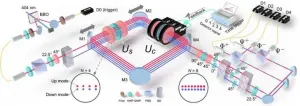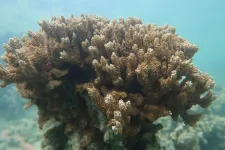(Press-News.org) San Antonio, Texas (January 4, 2020) - Scientists at Texas Biomedical Research Institute (Texas Biomed) and Southwest National Primate Research Center (SNPRC) published their findings regarding a comprehensive animal model study of SARS-CoV-2 in the peer-reviewed journal Nature Microbiology. These findings were originally posted online in BioRxiv in June of 2020. The study evaluated three nonhuman primate (NHP) species (Indian rhesus macaques, African baboons and new-world origin common marmosets) and young and old animals, to determine susceptibility to the SARS-CoV-2 virus and the development of COVID-19 disease. Over the course of the study, the macaque and baboon models showed significant promise as animal models for COVID-19 disease studies moving forward. Based on outcomes, the researchers recommended use of the macaque as a model to help develop vaccines, while the baboon showed greater disease development, making it a potential option for evaluating anti-viral therapeutics and co-morbidities, such as understanding the connection between COVID-19 and diabetes or COVID-19 and heart disease.
"Thanks to the support of our community, Texas Biomed was able to launch and complete the most comprehensive animal model study to date (June 2020) that has provides scientists greater understanding of the immune response to SARS-CoV-2 and definitively identifies two possible animal models to help move vaccines and therapeutics forward," said Larry Schlesinger, M.D., Texas Biomed President and CEO. "The speed and completeness to which this team of researchers operated to execute this study is nothing short of heroic. I am very pleased at the progress the Institute is making in our COVID-19 studies and believe this is the first of many discoveries to come."
COVID-19 is the defining pandemic of a generation. Texas Biomed launched this study in late March 2020 because animal models are a critical component of the biomedical pipeline necessary to fast track drug and vaccine development. The study was completed by May 2020.
"The benefit of Texas Biomed's unique research model lies in the expertise to support individual scientific study and contract research on one campus with the animal, biosafety and regulatory proficiency to help shepherd research from basic discovery through preclinical development and on to human clinical trials," explained Joanne Turner, PhD, Vice President for Research at Texas Biomed.
Animal models for infectious diseases, such as COVID-19, are allowing scientists worldwide to determine whether the candidate vaccines and antiviral therapeutics currently under development will be viable as human interventions. Additionally, animal models enable scientists to understand how the disease progresses in people with compromised immune systems to assist in the development of treatments for these individuals.
"Finding the appropriate animal models for COVID-19 allows for these critical discoveries to happen now, and they are an important step in combatting this disease," said Dr. Deepak Kaushal, PhD, Director of the Southwest National Primate Research Center and lead Principal Investigator on the macaque portion of the study. "Without well-documented animal data, the FDA is unlikely to license a vaccine or antiviral therapy for human use, even those currently undergoing human trials, because animal model data assure us that we have a complete picture of the disease and how humans may respond to potential therapies."
The team of 43 researchers reported clinical, viral, imaging, immunological and histopathological (tissue examination) findings during SARS-CoV-2 infection/COVID-19 disease in all three species of NHPs. The study ultimately found that nonhuman primates showed similar progression of SARS-CoV-2 infection to that of humans, with some becoming more ill than others, and signs of the virus in both the upper and lower respiratory tracts and signs of pneumonia.
"Our results tell us that these animal models will provide relevant, quantifiable information moving forward as we delve deeper into understanding the disease and targets for therapeutics and vaccines for human trials," Dr. Kaushal explained.
While previous animal studies showed the macaque to be a viable model for SARS-CoV-2, this was the first time that researchers performed a longitudinal study of three different NHPs (looking at disease progression factors over several days) and in both young and older macaques to determine if age is a factor in disease progression. Moreover, the researchers used the most comprehensive set of evaluations, ranging from bronchoalveolar lavages (lung fluid collection) and nasal swabs to determine virus presence to chest x-rays and CT scans to evaluate lung health after infection.
Results showed that the macaque and baboon models develop strong signs of acute viral infection leading to pneumonia, and the NHP immune system mounts a strong response and clears the infection. Specialized sets of myeloid cells (phagocytes) move from blood to the lungs and secrete high levels of Type I interferons, cytokines or proteins that send chemical messages required for controlling viruses in general and coronaviruses in particular. The appearance of these specialized phagocytes (cells that ingest foreign particles or dying cells in the body) corresponded with a decline in measurable amounts of virus and disease parameters. The longitudinal study of young and old animals showed little difference. However, the virus appears to persist and shed longer in the baboons and create greater pathology in the lungs. The marmoset model did not show any significant signs of disease progression.
This study was also the first report of SARS-CoV-2 infection specifically altering lymphoid cells (T cells) in the lung, which generated a strong and very specific immune response in the macaque, enabling the animals to clear the virus. This finding indicates the NHP model will be useful in understanding the immune response to SARS-CoV-2 and aid in the development of interventions that can create a similar response, as well as help evaluate the safety and effectiveness of vaccines, which require a specific immune response in order to be effective.
"While this study was not the first to indicate the macaque would serve as a good model for SARS-CoV-2, the study provides strong scientific evidence in support of this model, as well as the first evidence of the baboon model via comprehensive, clinically-relevant and well-documented research with controls," Dr. Kaushal said. "We strongly believe macaques and baboons will be very helpful in evaluating interventions that generate the strong immune response seen in these animal models."
The study was funded by philanthropic support from more than 300 donors after a call-to-action campaign was launched in late March. The campaign raised more than $3.5 million in one week, and additional donor support has brought the total raise for COVID-19 research at Texas Biomed to more than $5.7 million.
Concurrently, Texas Biomed investigators are submitting several grant applications to the National Institutes of Health and other federal agencies to further these study findings and develop novel vaccine candidates, diagnostics and therapeutics. Scientists have already begun collaborative immune system and co-morbidity studies, as well as small animal model development studies in rodents and guinea pigs. Additionally, the Institute is collaborating with several pharmaceutical and research and development partners to test vaccine and therapeutic candidates.
INFORMATION:
Texas Biomed is one of the world's leading independent biomedical research institutions dedicated to eradicating infection and advancing health worldwide through innovative biomedical research. Texas Biomed partners with researchers and institutions around the world to develop vaccines and therapeutics against viral pathogens causing AIDS, hepatitis, hemorrhagic fever, tuberculosis and parasitic diseases responsible for malaria and schistosomiasis disease. The Institute has programs in host-pathogen interaction, disease intervention and prevention and population health to understand the links between infectious diseases and other diseases such as aging, cardiovascular disease, diabetes and obesity. For more information on Texas Biomed, go to http://www.TxBiomed.org.
TAMPA, Fla (Jan 4, 2021) -- Despite the progress made in managing asthma and chronic obstructive pulmonary disease (COPD), poorly controlled symptoms for both respiratory diseases can lead to severe shortness of breath, hospitalizations or even death.
"Only about 50 percent of asthmatics, and an even lower percentage of people with COPD, achieve adequate control of lung inflammation and airway constriction with currently available medications," said END ...
There has been frequent occurrence of red tide in coastal waters around Korea where the sea turns red. Red tide is a phenomenon in which phytoplankton proliferate as nutrient or sewage flow into seawater, making it appear red. This not only causes damage to the fisheries industry but also affects the marine ecosystem.
Professor Kitack Lee and Ph.D. candidate Ji-Young Moon (first author) of POSTECH's Division of Environmental Science and Engineering have confirmed that the inflow of nitrogen pollutants since the 1980s has disturbed the nutrient balance in the northeast Asian waters and is changing the species of phytoplankton responsible for red tide. The team also found that the ...
A team of researchers from the National University of Singapore (NUS) has created a novel film that is very effective in evaporating sweat from our skin to keep us cool and comfortable when we exercise, and the moisture harvested from human sweat can be used to power wearable electronic devices such as watches, fitness trackers, and more.
Sweating is a natural process for our body to reduce thermal stress. "Sweat is mostly composed of water. When water is evaporated from the skin surface, it lowers the skin temperature and we feel cooler. In our new invention, we created a novel film that is extremely effective in evaporating ...
Real-life applications like magnetometry or quantum gyroscope typically involve precise measurement on multiple parameters. How to achieve the ultimate precision limits simultaneously is a long sought-after grail in the field.
It is widely believed that the ultimate precision limits for all parameters cannot be achieved simultaneously, since generators of different parameters are generally non-commuting, which induces the trade-offs among the precisions.
Yet such trade-offs are escaped from by the group of Prof. LI Chuanfeng and Prof. XIANG Guoyong from Key Laboratory of Quantum Information at University of Science and ...
Researchers have found a novel way to identify heat-stressed corals, which could help scientists pinpoint the coral species that need protection from warming ocean waters linked to climate change, according to a Rutgers-led study.
"This is similar to a blood test to assess human health," said senior author Debashish Bhattacharya, a Distinguished Professor in the Department of Biochemistry and Microbiology in the School of Environmental and Biological Sciences at Rutgers University-New Brunswick. "We can assess coral health by measuring the metabolites (chemicals created for metabolism) they produce and, ultimately, identify the best interventions to ensure reef health. Coral bleaching from warming ...
DALLAS, Jan. 4, 2021 -- Smoking traditional cigarettes in addition to using e-cigarettes results in harmful health effects similar to smoking cigarettes exclusively, according to new research published today in the American Heart Association's flagship journal Circulation.
Smoking, a well-known link to cardiovascular disease and death, appears to be on the decline. While the use of e-cigarettes, known as vaping, is increasingly popular, there has been limited research on the impact of vaping on the body.
In a large data analysis of more than 7,100 U.S. adults ages 18 and older, researchers studied the association of cigarette smoking and e-cigarette use with inflammation and oxidative stress as biomarkers. Inflammation and ...
To effectively combat an infection, the body first has to sense it's been invaded, then the affected tissue must send out signals to corral resources to fight the intruder. Knowing more about these early stages of pathogen recognition and response may provide scientists with crucial clues when it comes to preventing infections or treating inflammatory diseases resulting from overactive immunity.
That was the intent behind a new study, led by researchers at the University of Pennsylvania School of Veterinary Medicine, examining infection with the parasite Cryptosporidium. ...
To control mosquito populations and prevent them from transmitting diseases such as malaria, many researchers are pursuing strategies in mosquito genetic engineering. A new Texas A&M AgriLife Research project aims to enable temporary "test runs" of proposed genetic changes in mosquitoes, after which the changes remove themselves from the mosquitoes' genetic code.
The project's first results were published on Dec. 28 in Philosophical Transactions of the Royal Society B, titled "Making gene drive biodegradable."
Zach ...
What The Patient Page Says: We have all lived with COVID-19 for about a year now. Overall, we have learned that children get sick less often than adults, but a few children have gotten severely sick. This update summarizes the current understanding of how children are affected and gives ways to keep families safe as children continue to grow and thrive.
Authors: Lindsay A. Thompson, M.D., M.S., and Sonja A. Rasmussen, M.D., M.S., of the University of Florida College of Medicine in Gainesville, are the authors.
To access the embargoed study: Visit our For The Media website at this link https://media.jamanetwork.com/
(doi:10.1001/jamapediatrics.2020.5817)
Editor's ...
What The Study Did: Researchers looked at whether health outcomes of white citizens living in the richest U.S. counties were better than that of average individuals in other developed countries.
Authors: Ezekiel J. Emanuel, M.D., Ph.D., of the University of Pennsylvania in Philadelphia, is the corresponding author.
To access the embargoed study: Visit our For The Media website at this link https://media.jamanetwork.com/
(doi:10.1001/jamainternmed.2020.7484)
Editor's Note: The article includes conflicts of interest disclosures. Please see the article for additional information, including other authors, author contributions ...



